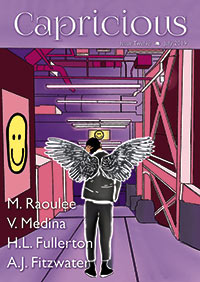Karen Burnham Reviews Short Fiction: Capricious SF, Strange Horizons, and Current Futures
 Capricious SF 7/19
Capricious SF 7/19
Strange Horizons 9/30/19
Current Futures: A Sci-Fi Ocean Anthology, Ann VanderMeer, ed. (XPRIZE) June 2019.
I wanted to make sure to catch up with Capricious as, according to editor A.C. Buchanan, the magazine will be taking a hiatus through at least the summer of 2020. I feel that Capricious has been putting out some wonderfully innovative short fiction recently, and I’m happy to say that issue 12 keeps up that reputation. It leads with “Lemon Flowers” by M. Raoulee, a story of a spacer and an alien race. The Sovers are empathic aliens, but it’s hard to be on a spaceship with them when they’re sleeping – sometimes their empathy reverses and they project their dreams. The protagonist caught a particularly vivid scene on an early voyage, and found that they had no problem with the sensation. As their career advances, they start to specialize in ferrying Sovers on various diplomatic missions. One trio of passengers includes a young male, Harper, who seems to be more fascinated by the workings of the ship than the mission. Eventually, the captain takes an interest in him and his fate. There are lovely descriptions here, both of the dream scenes and vignettes of Captain Estevez’s career, and the ending is quite satisfying. More formally experimental is “When Are You Wearing” by H.L. Fullerton. In this second-person POV story, you are Narcissa Bloom, a high-end fashion designer, trapped in some way both by fashion and by time warlocks. Wearing different outfits takes you to different moments of your past, especially with your wife/girlfriend Fee, but you find yourself unable to move into any new tomorrows. A nicely done extended metaphor. Moving to a different art form, “Power Chord” by A.J. Fitzwater imagines a spaceship crewed by the most diverse collective imaginable, getting ready to leave a wrecked Earth behind. On the same day that a sham treaty is being signed to bring a putative end to the “Water Wars,” Surl is getting set up to broadcast the ship’s launch/raucous concert to an audience of at least six hundred million people. Although there’s not much hope for Earth here, it points to a measure of hope for the future overall. Finally “This Was Never a Vigil” by V. Medina gives us a succession of people waking up in a room with notes on their hands to drink water and to come up with a name for themselves. Each reacts differently to the advice and to caretaker Cin. It becomes clear that this is a waystation of the afterlife, but only at the very end do we find out just what Cin has been waiting for.
At the end of September, Strange Horizons ran a special issue dedicated to speculative fiction from Brazil, featuring five short stories, three poems, and an excellent non-fiction article on “The State of Play of Brazilian SFF” by Jana Bianchi. The stories showcase a nice range, from the science fictional to the fantastic. On the SF end, “Replacement” by Isa Prospero imagines a near future where the young in favelas sell body parts to those richer people that need them, everything from limbs to eyes to hearts. Jô ends up selling his heart in exchange for a very poignant item. There’s also a very short thought experiment involving flying autonomous vehicles in “High Hopes” by Kali de los Santos. It starts from that premise and folds in our advertising-based economy centered on renting rather than owning, and within ten years gets to a dramatic showdown that brings society to a standstill. This story accomplishes exactly what it sets out to do and raises several points worth attention.
On the more fantastic side, “Spider” by Sérgio Motta features a young boy, Heitor, who is hungry for stories. He winds up listening to an old man on the street even when he should be caring for his younger sister; the identity of the man is the heart of the story. Finally, “Ajé” by H. Pueyo is a character portrait. Ajé is a kind of magical animating power, and all four characters here can wield it. A father and son come to visit a mother and daughter to enlist their help resolving a magical anomaly. The mother is in a highly abusive relationship and has turned her back on ajé, but is willing to support her daughter’s promise. The boy is just learning his craft and is also entranced by the daughter, especially her ability to carry cold air around herself in the sweltering heat. The father and mother knew each other way back, and seeing each other reminds them of different times in their lives and highlights for them how their lives have turned out. The story gives enough space for all of the relationships between them to be explored. The plot itself is quiet in comparison to the foregrounded, but never melodramatic, relationships. This is a considerably more sensitive story than the vast majority I read.
One big release of 2019 that was easy to miss is Current Futures: A Sci-Fi Ocean Anthology, funded by the XPrize Foundation and edited by Ann VanderMeer. Available only online, it didn’t seem to generate the buzz that might have been expected, given the heavy hitters found in the table of contents (and the lovely commissioned artwork accompanying each story). The one downside to a tightly focused anthology such as this one (near-future, ocean-based SF) is that there can be a certain similarity echoing throughout the stories. As such, there are a lot of stories here about communicating with sea creatures. The anthology leads off with “Mother Ocean” by Vandana Singh, imagining a woman learning to speak with a specific blue whale as part of reconnecting with an island heritage her mother forcefully denied. While in the main plot the woman has to save the whale after it almost swallows castoff undersea cables, there is also a lot here about different epistemologies and how they can help us in the future. In “Talking in Pictures” by Sheila Finch, technologically mediated brain-to-brain communication is possible with dolphins, and it allows the heroine of that story to rescue a trapped dolphin in an underwater greenhouse of sorts. “Improvisations on an Ocean Call” by Rochita Loenen-Ruiz gives us a genetically engineered young woman who transitions between the terrestrial world of her researcher mother and the ocean world that seems more like home to her, even when it harms her. She helps organize the worldwide viewing of an underwater concert that occurs naturally when migrating whales intersect with each other in a specific region of the ocean, helping to bridge the divide between worlds. “Sturdy Lanterns and Ladders” by Malka Older has brain-to-brain communication possible, with a freelance researcher getting a glimpse into the mind of an octopus. It’s heartbreaking when she experiences the octopus’s memories of the now-barren coral reef where it spent most of its life, but the overall goal is to make the octopus a partner of sorts in restoring the reef habitat, a very interesting idea. In “Her Seal Skin Coat” by Lauren Beukes, a full-body immersion rig lets tourists and scientists alike experience slices of life as Antarctic seals, with one researcher feeling much more comfortable as a seal, even when confronted by orcas, than when having to deal with humans. Towards the end of the volume Catherynne M. Valente goes all the way across the animal-human divide and brings us a story from a pregnant whale’s point of view, complete with their own mythos in “The Seething Sea Suffices Us“.
Another item of fascination is coral and the many uses it might have. In “Repatriation” by Nalo Hopkinson (one of the most fun entries here) a new species of coral and, poetically, some derelict cruise ships might be the key to a surprise homecoming for a Jamaican gentleman and his husband. “Sea Maple” by Marie Lu imagines a new species of long-lived coral and the researcher who discovered it giving her very sick little sister a tour. The descriptions here are absolutely vivid. And the characters in “The Salt Dark” by Deborah Biancotti have to deal with coral thieves at their habitat restoration site.
The ocean means many things to many people, but this anthology makes a forceful argument that it is central to humanity’s future. In “Haven” by Karen Lord, new artificial islands might be crucial to the calculus of microstate survival, both in the face of more aggressive hurricanes and more hostile United Nations political maneuvers. Isopods inspire more efficient deep-water mining techniques in “The Little Shepherdess” by Gwyneth Jones. In “Soft Edges” by Elizabeth Bear, a researcher on a coastal restoration and protection project has an opportunity to solve a murder but also has to deal with her conflicted conscience over the unjust nature of the criminal justice system. Providing a perfect grace note to the volume, Brenda Cooper imagines an ORIAS program in “Southern Residents” that is ostensibly focused on saving whales in the Salish Sea (near Washington State in the US), but makes the case that they have to treat the entire ecosystem holistically in order to accomplish their mission. During the grand opening, the director of the program adopts a skeptical journalism student and vlogger from Texas, to show her both the wonders of the ocean and also the interconnectedness of the world’s systems. I’d say that this anthology makes that point altogether effectively, although I fear that it will largely be preaching only to the already convinced.
Recommended Stories
“Soft Edges”, Elizabeth Bear (Current Futures)
“Sea Maple”, Marie Lu (Current Futures)
“Sturdy Lanterns and Ladders”, Malka Older (Current Futures)
“Ajé”, H. Pueyo (Strange Horizons 9/30/19)
“Lemon Flowers”, M. Raoulee (Capricious 7/19)
Karen Burnham is an electromagnetics engineer by way of vocation, and a book reviewer/critic by way of avocation. She has worked on NASA projects including the Dream Chaser spacecraft and currently works in the automotive industry in Michigan. She has reviewed for venues such as Locus Magazine, NYRSF, Strange Horizons, SFSignal.com, and Cascadia Subduction Zone. She has produced podcasts for Locusmag.com and SFSignal.com, especially SF Crossing the Gulf with Karen Lord. Her book on Greg Egan came out from University of Illinois Press in 2014, and she has twice been nominated in the Best Non Fiction category of the British SF Awards.
This review and more like it in the January 2020 issue of Locus.
 While you are here, please take a moment to support Locus with a one-time or recurring donation. We rely on reader donations to keep the magazine and site going, and would like to keep the site paywall free, but WE NEED YOUR FINANCIAL SUPPORT to continue quality coverage of the science fiction and fantasy field.
While you are here, please take a moment to support Locus with a one-time or recurring donation. We rely on reader donations to keep the magazine and site going, and would like to keep the site paywall free, but WE NEED YOUR FINANCIAL SUPPORT to continue quality coverage of the science fiction and fantasy field.







